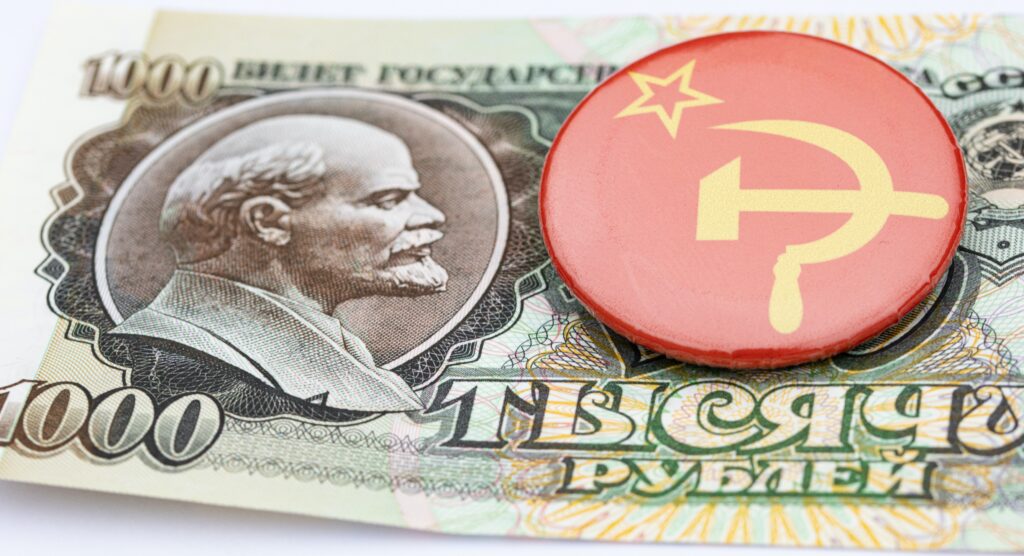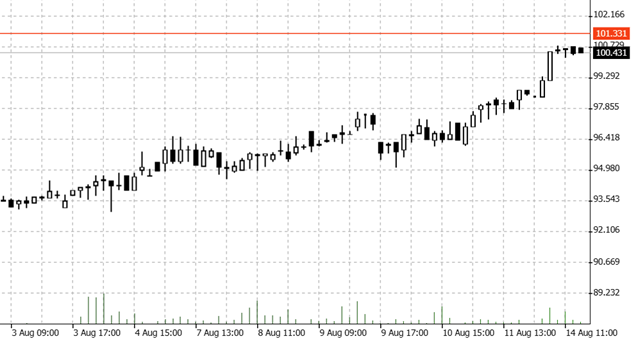

14.08.2023 – Here we are again: USDRUB has crashed to the 100 mark. Weeks ago, the euro had already reached the magic 100 mark. The bear market reflects the cracks in the Russian state foundation, which have caused a massive flight of capital.
The ruble is again as weak as it last was in March 2022. Here is the hourly chart of USDRUB. We now suspect countermeasures soon, which could bring profits back to traders on the long side: Moscow wants to buy no more foreign currencies on the world market until the end of the year. In contrast, foreign currencies from the state fund of up to $23 million are to be sold per day. In addition, the Interfax news agency, citing the Central Bank, reported that a hike at the next regular meeting in September is possible. Perhaps it will be another significant rate hike.

Source: Bernstein Bank GmbH
The ruble had already made strong gains shortly after the Ukraine invasion – from 138 it went down to 52 rubles per greenback. This was due to a fireworks display of countermeasures by the Russian state and central bank, which now seems to have burned off. Strict capital controls, rapidly rising energy prices and a collapse in imports to Russia had initially strengthened the ruble. Plus, of course, a hefty interest rate hike: shortly after the invasion began, the central bank had raised its key rate from 9.5 to 20 percent on Feb. 28, 2022. Then it went back down again. And this July, the central bank raised its key interest rate from 7.5 to 8.5 percent.
Fewer petrodollars
Now, however, things look bleak for the ruble. The cost of war is rising. Western sanctions are taking effect. India or China are getting discount prices on oil and gas. In 2022, Russia’s foreign trade surplus had risen to a record $332 billion. But it has fallen by 80 percent, according to the central bank. Russia’s state budget closed with a deficit of 2.6 trillion rubles, or about 26 billion euros, in the first half of the year. Moscow just reported a budget deficit for the eighth month in a row.
There are also problems in politics. It was not only the strange Prigozhin coup in June that first exposed cracks in the system. At the end of June, even oligarch Oleg Deripaska criticized the invasion of Ukraine as a “colossal mistake” – and the Rusal boss spoke of a “war.” Which usually results in immediate imprisonment.
Haishenwai, Kuyedao and Xing’an
Foreign policy standoffs are also taking place. Turkey has visibly moved away from Russia with the NATO release of Finland and Sweden and the release of Ukrainian soldiers from the Azov regiment-perhaps only for now, perhaps forever.
Beijing, too, is by no means unconditionally on Moscow’s side. As early as April, the “Neue Zürcher Zeitung” pointed out an interesting detail from China. According to a ministerial decree, Russia’s Pacific metropolis Vladivostok must now be called “Haishenwai” again on Chinese maps. Sakhalin Island must be called “Kuyedao”. And the Stanovoi Mountains “Outer Xing’an Mountains”. It looks like Beijing never accepted the loss of its territories to Russia and the “unequal treaties” of the 19th century. Who knows – maybe Chinese tanks will roll into Siberia someday.
Our conclusion from all this: The ruble remains a seismograph for the state of Russia. But a lasting recovery can only be expected if Russia is reintegrated into the global economy. If Russia prevails in the trench warfare in Ukraine, enough Western companies will be ready to invest in the Russian Federation again. We are curious to see what will happen next and wish successful trades and investments!
____________________________________________________________________________________________________________________________________________________________________________
The content of this publication is for general information purposes only. In this context, it is neither an individual investment recommendation or advice nor an offer to purchase or sell securities or other financial products. The content in question and all the information contained therein do not in any way replace individual investor- or investment-oriented advice. No reliable forecast or indication for the future is possible with respect to any presentation or information on the present or past performance of the relevant underlying assets. All information and data presented in this publication are based on reliable sources. However, Bernstein Bank does not guarantee that the information and data contained in this publication is up-to-date, correct and complete. Securities traded on the financial markets are subject to price fluctuations. A contract for difference (CFD) is also a financial instrument with leverage effect. Against this backdrop, CFD trading involves a high risk up to the point of total loss and may not be suitable for all investors. Therefore, make sure that you have fully understood all the correlating risks. If necessary, ask for independent advice. CFDs are complex instruments and are associated with the high risk of losing money quickly because of the leverage effect. 68% of retail investor accounts lose money trading CFD with this provider. You should consider whether you understand how CFD work and whether you can afford to take the high risk of losing your money.7
